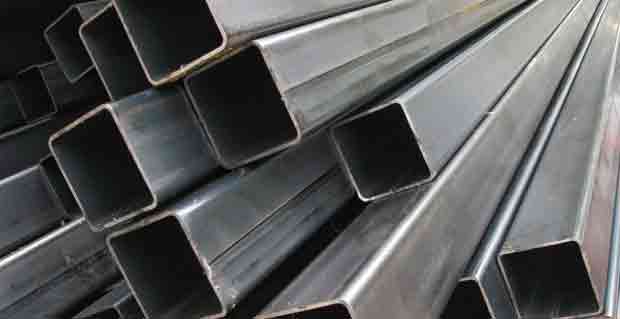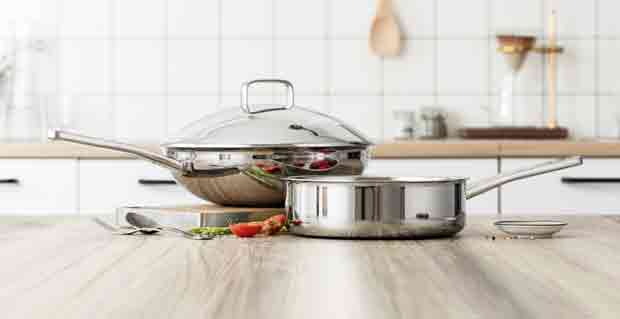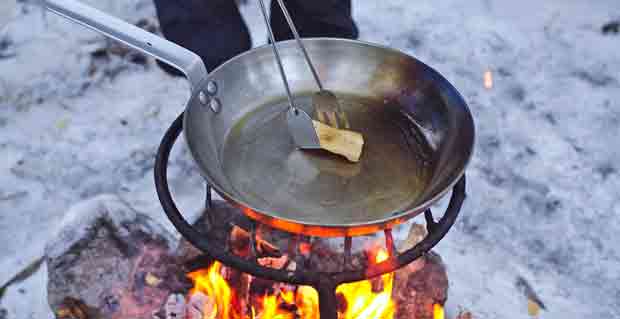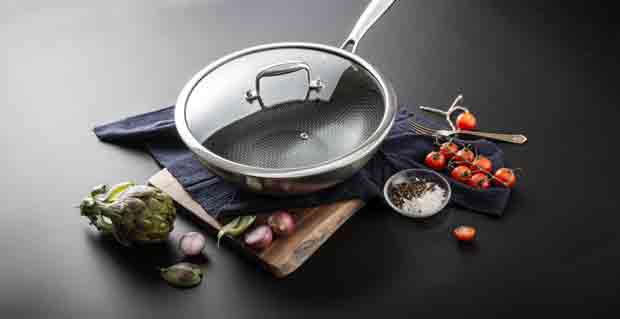A wok is a large round bottom cooking vessel, originating from China. Woks are used primarily for stir frying and deep frying as well as steaming and boiling.
The design of the wok allows for a quick turnaround of ingredients because it has a large surface area which allows for more contact with hot oil or water than other types of cookware.
Mainly, the wok material is either carbon steel or stainless steel. Let's see carbon steel vs stainless steel's wok differences.
Carbon Steel

Carbon steel woks are made from a type of iron that contains carbon. They are typically lighter in weight and thinner than stainless steel pans, but become less durable over time.
Carbon steel is the more traditional material for woks because it heats up quickly and cools down fast due to its high conductivity. However, it also rusts easily.
Stainless Steel
Stainless steel pans are made from a type of iron that contains chromium and nickel. They're typically heavier and thicker than carbon steel, but still retain the non-stick property of carbon steel.
Stainless steel does not rust or tarnish over time and retains its high conductivity even on the outside of the wok.
Comparison Between Carbon Steel vs Stainless Steel
01) Heat Retention
Carbon steel heats up quickly and cools down fairly quickly, but stainless steel takes longer to heat up and cool down.
02) The Heat Distribution
When it comes to heat distribution, carbon steel is better than stainless steel.
Carbon steel has a larger surface area which allows for more contact with hot oil or water than stainless steel.
High heat distribution is much more evenly with it and it is very durable. This results in faster cooking and benefits those who are skilled at cooking.
03) Amount of Heat Tolerated
Carbon steel is able to handle a larger amount of heat because it has a higher conductivity heat rate than stainless steel heat.
04) Building Materials

Carbon steel woks are typically made of carbon steel and can be coated with other metals. Stainless steel is typically made of chromium, nickel, and 18/8 or 18/10 stainless steel.
It is not magnetic, but it will stain after repeated use. Stainless steel pans are typically made of 18/10 stainless steel to avoid rusting.
05) Durability
Stainless steel is more durable than carbon steel because it doesn't rust or tarnish.
However, stainless steel also weighs more and is not as conductive as carbon steel on the outside of cookware for some reason.
06) Non Stick
Both carbon steel and stainless steel are fairly non-stick at the beginning of use. However, over time carbon steel becomes less non-stick because it rusts easily.
Stainless steel can last longer, but is not as non-stick as carbon steel at the beginning of use.
07) Services of Maintenance and Cleaning
Both carbon steel and stainless steel wok require less maintenance and cleaning. Stainless steel is non stick and rust proof, but carbon steel is lighter in weight and has a smoother surface.
Carbon steel requires more care in use because it rusts easily when water comes into contact. However, both types of cookware can be cleaned with a sponge and soap, and polished with salt after use.
08) Food Reactivity
Carbon steel is reactive to high acid foods, but stainless steel is not. This is because stainless steel contains nickel which inhibits reactivity.
09) Safety and Health
Stainless steel is non toxic and food safe, but carbon steel can sometimes contain lead and other toxins in the manufacturing process and when exposed to high heat.
10) Pricing and Availability
Stainless steel pans are typically more expensive than carbon steel woks because of their superior durability and high conductivity rates.
Both types of steel woks are widely available at most cookware shops and online retailers.
Appearance of Carbon Steel and Stainless Steel Wok

Carbon Steel Wok
Carbon steel wok are typically black in color. Carbon steel woks are thinner than stainless steel pans, about 1 mm to 2.25 mm thick, and the walls of the wok curve inward to form a bowl shape. The bowl shape allows food to be kept inside the wok even if the plates are turned over.
Stainless Steel Wok
Stainless steel is silver in color. Stainless steel pans are thicker than carbon steel wok, about 2 mm to 4 mm thick, and the walls do not curve inward to form a bowl shape. The straight sides of stainless steel pans make it easy for cooks to scoop food out.
Some Tips for Using a Wok
Use a wok ring when using an electric stove to bake on low heat or in a glass top cooker.
Season your stainless steel or carbon steel wok with oils after purchase and before the first use.
Clean your wok with cold water and a sponge after each use while it is still hot, and dry thoroughly without rinsing.
Don't wait for food to burn in the wok because it will be difficult or impossible to remove after a certain point.
Avoid using an abrasive scrubber, steel wool, metal sponge, wire brush and dishwasher cleaners on carbon steel pans as they can damage the coatings over time.
Never use your stainless steel or carbon steel wok for deep cooking and plan on cooking with low to medium heat.
Never leave a carbon steel or stainless steel wok in water for an extended period of time because rusting will occur.
Always season your wok before using it the first time with butter. After that, use vegetable shortening, peanut oils, or lard for best results.
Clean your stainless steel or carbon steel wok after each use to keep it in good condition and avoid rusting.
To remove rust from a carbon steel pan, cut a potato in half and rub both surfaces of the pan with it until all rust is removed. Then wash with warm water and dry thoroughly without rinsing.
A Few More Thoughts About Cooking Woks

How Do Stainless Steel Pans Work?
A stainless steel pan can be used as a frying pan or saucepan, but the most typical use is as a sauté pan or frying pan.
They usually have a rounded bottom and sloping sides which make them perfect for tossing ingredients while cooking.
Stainless steel pans are useful for preserving the non-stick nature of food because they can handle high temperatures. They're also durable and easy to clean.
How Does Carbon Steel Pan Work?
Carbon steel pans are typically made of a single layer of metal that is 100% iron. They come in two styles: "Wok friendly", which has a rounded bottom and sloping sides, and traditional which is basically flat.
Carbon steel pans can be seasoned to make food non-stick and allow for an easy cleanup.
However, these pans take time to season and require more care to maintain than other types. If you're looking for fast cooking and prefer no setup, carbon steel is not for you.
How Do Cast Iron Woks Work?
For those looking for fast cooking and don't mind the time it takes to season, cast iron woks are perfect.
They're typically thicker than carbon steel woks and cast iron woks, which means they retain heat for a longer period of time.
These pans are heavy and require a cast iron skillet holder to protect the countertop from scratches.
Some cast iron woks come with a flat bottom for use on electric stoves and some cast iron skillets are sold with a non-stick coating.
A cast iron wok or cast iron skillet with non-stick coating is easier to clean than traditional cast iron pans that require seasoning.
What is Better, A Carbon Steel or Stainless Steel Wok?
The answer to this question depends on your needs and skills. If you're a skilled cook, carbon steel pans are the best option because they heat up quickly and cool down fast.
For environmentally-friendly options that won't rust or tarnish over time, stainless steel pans are perfect.
How Do Non-Stick or Teflon-Coated Woks Work?

Non-stick or Teflon coated woks are perfect for people who want to avoid the work of seasoning and maintaining traditional pans.
Non-stick pans are coated with silicone, which means they should never need greasing each time before cooking. They're generally best for those who like to cook without too much fussing around with their dishes.
How Can You Choose the Right Wok for You?
The first thing to consider when choosing a wok is the type of cooking you want to do. Different stainless steel wok and carbon steel wok are made for different types of cooking, so you will have to choose the right one for what you need it for.
The second thing to consider is what material your steel pans should be made out of. Carbon steel and stainless steel both have their advantages, but it really depends on your skill level and budget which one would be best suited for you.
FAQs
01. What Is the Best Metal to Use for A Wok?
The best material for a wok is carbon steel because it heats up quickly and cools down fast. Stainless steel is also a good option, but one should note that stainless steel will not rust or tarnish over time. This makes it more environmentally friendly than carbon steel.
02. What is the Best Type of Cooking Wok to Use?
A round bottomed wok is the best type of cooking wok to use. This is because it provides more stability, heating up evenly across the entire pan.
A flat bottomed wok (the more typical type seen in the west) is not recommended because it lacks this stability and tends to cook unevenly.
03. What is the Best Way to Season a Wok?
The best way to season a wok is by leaving it uncoated and letting natural oils such as those from beef tallow or lard accumulate at the bottom of the pan.
Then, heat it to a high temperature causing these oils to smoke and cook into the carbon steel wok. Once this happens, wipe off any excess with a paper towel.
04. Why Do Some Woks Come Coated?
Some steel pans are coated because these coatings can prevent rusting, tarnishing, and sticking. However, this makes it difficult to season the wok correctly or remove it if required.
Unless one has all the necessary tools needed to do so, it may be best to avoid buying a coated wok.
05. What Are Some Foods That Should Not Be Cooked in a Wok?
Some foods that should not be cooked in a wok include: 1) beans and 2) delicate foods such as poached eggs.
These foods should be cooked in pots instead of steel pans to avoid them becoming overcooked.
06. Should I Use a Lid for My Wok?
Yes, a wok should always have a lid. This is because it traps heat inside the pan and therefore ensures most of the moisture from cooking foods evaporates instead of being cooked off by the steam.
In this way, food is kept moist but also done throughout.
07. What Size Wok Should I Use?
A medium sized 10 to 14-inch wok is the best size for a home cook to use. Larger models are less practical, but still doable.
Smaller ones can be used as well, but one should keep in mind they may not be the best option because they lack surface area and therefore heating capabilities.
08. How Do I Know if My Wok Needs to Be Replaced?
If one's wok is starting to rust and peel, it should be replaced. The same goes if food starts sticking too often and becomes difficult to clean.
Otherwise, carbon steel pans can last for decades with proper care. Stainless steel ones on the other hand will not become rusty or tarnish, but will need to be replaced after a few years because the non-stick coating will wear off.
09. What Is the Best Stove for Wok Cooking?
The best stove for wok cooking is one that allows the flames to come in direct contact with the bottom of the pan.
One exception is an electric range, which has heating coils in place of flames. While this may not be ideal for stir-frying, it can still cook dishes at a reasonable speed.
As well, gas stoves are often more ideal for wok cookers because they heat up quickly and also cool down fast.
Electric stoves on the other hand, take longer to heat up but hold their temperature well once this is done.
10. Which Handles Should I Use On My Wok?
The best handles for a stainless and carbon steel wok are ones that are riveted in place. This is because they have more stability and will not move around when exposed to high flames or heat.
Silicone coated handles are also good to use, but avoid ones that are hollow metal or wood. These can easily burn through over time if one keeps the pan over an open flame.
Conclusion
Carbon steel is more resistant to rust, but it scratches easily. Stainless steel woks are non-stick and will be easier to clean up after cooking with oil or sauce on the pan. Which of these qualities does your kitchen favor?

![Best Wood for Rolling Pins Reviews in 2022 [Top 5 Picks] Best Wood for Rolling Pins Reviews in 2022 [Top 5 Picks]](https://mykitchening.com/wp-content/uploads/2022/01/Best-Wood-For-Rolling-Pins-211x150.webp)

